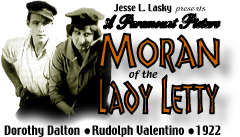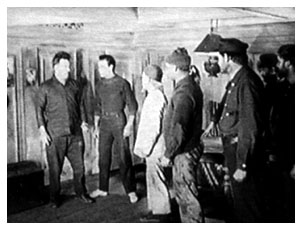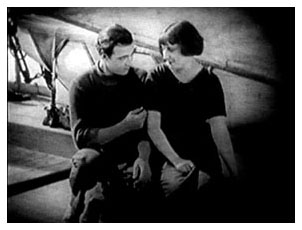

Cast: Dorothy Dalton (Letty "Moran" Sternersen), Rudolph Valentino (Ramon Laredo), Charles Brinley (Captain Sternersen), Walter Long (Captain Kitchell), Emil Jorgenson (Nels), Maude Wayne (Josephine Herrick), Cecil Holland (Bill Trim), George Kuwa ("Chopstick" Charlie), Charles K. French (tavern owner)
Ramon Laredo is a young socialite who is shanghaied at the
San Francisco docks on his way to a yachting trip. The ship is
run by Captain Kitchell who smuggles between the California and
Mexican coasts. He soon proves himself equal to the other men
on the ship defeating one in a fight and showing his skill as
a seaman. He is soon promoted to first mate. They come upon
a Norwegian ship, the Lady Letty, that is burning. Those who
did not desert the ship have been killed by the coal fumes, except
Moran, the daughter of  the Lady Letty's
captain. She is unconscious, and Ramon carries her back to the
smugglers' ship. He challenges Kitchell who tries to sneak into
Moran's cabin at night, and Kitchell backs down. In Mexico, Kitchell
plots with the local bandit and his men to kill the crew and keep
the goods they have smuggled for themselves. The cook, "Chopstick"
Charlie, overhears the plans and returns to tell Ramon. Ramon
rallies the crew who ready themselves for the arrival of the bandits
whom they defeat. Unbeknownst to Ramon or the crew, Kitchell
was knocked unconscious and fell into the ship's hold. There
he awaits their arrival in San Diego so he can exact his revenge
on Ramon and take Moran for himself. Upon their arrival, all
the crew goes into town, and Ramon leaves to call his family and
inform them he is safe. Moran chooses to remain on ship. Ramon
goes to a hotel to use the telephone and runs into his old friends.
Although they try to get him to "come back," he refuses
saying he has changed and wishes to go back to his new life on
the ship. However, he doesn't realize that while he's gone, Kitchell
is plotting to rape Moran. Will he return in time?
the Lady Letty's
captain. She is unconscious, and Ramon carries her back to the
smugglers' ship. He challenges Kitchell who tries to sneak into
Moran's cabin at night, and Kitchell backs down. In Mexico, Kitchell
plots with the local bandit and his men to kill the crew and keep
the goods they have smuggled for themselves. The cook, "Chopstick"
Charlie, overhears the plans and returns to tell Ramon. Ramon
rallies the crew who ready themselves for the arrival of the bandits
whom they defeat. Unbeknownst to Ramon or the crew, Kitchell
was knocked unconscious and fell into the ship's hold. There
he awaits their arrival in San Diego so he can exact his revenge
on Ramon and take Moran for himself. Upon their arrival, all
the crew goes into town, and Ramon leaves to call his family and
inform them he is safe. Moran chooses to remain on ship. Ramon
goes to a hotel to use the telephone and runs into his old friends.
Although they try to get him to "come back," he refuses
saying he has changed and wishes to go back to his new life on
the ship. However, he doesn't realize that while he's gone, Kitchell
is plotting to rape Moran. Will he return in time?
Oddly enough we hear very little about "Moran of the Lady Letty" although it was Valentino's follow-up film to "The Sheik" (1921). At the time "Letty" was being filmed, "The Sheik" was creating a sensation around the country and solidifying Valentino's status as a major star, along with his previous appearance in "The Four Horsemen of the Apocalypse" (1921). Of course, "Letty" has not been as readily available to film buffs over the years as has "The Sheik." Also, it doesn't lend itself to the Valentino mystique as the former film and subsequent films such as "Blood and Sand" (1922), "The Eagle" (1925) or "Son of the Sheik" (1926). It's a very straightforward role for him. In addition, the Valentino persona was still in transition at this time, and reviewers differed on what they liked or didn't like about this performance.
It must be remembered that Valentino had over 20 films to
his credit prior to "Letty," and in the majority of
them he was either villain, dapper socialite, gigolo or some combination
of these characterizations. The Variety (Feb. 10, 1922)
reviewer observed, "As a rough-and-tumble fighting hero,
Valentino is a revelation. Physically he looks the part, but
it comes as something of a shock, probably because he has so long
been identified with roles of a daintier kind." The New
York Times (Feb. 6, 1922) reviewer was  somewhat
more critical. "Rodolf Valentino, as the hero, of course,
is not so well-suited to the sea. He fits better into the romantic
and melodramatic excesses of the story . . . . he is too slick.
He doesn't impress one as the kind of youth who would be attracted
by Moran, except momentarily, or attractive to her. In some of
his scenes he is persuasive, but in others it seems a pity that
he ever left the ballroom. And it is through his character, too,
that the story becomes just movie stuff, so he naturally is not
as acceptable as the others."
somewhat
more critical. "Rodolf Valentino, as the hero, of course,
is not so well-suited to the sea. He fits better into the romantic
and melodramatic excesses of the story . . . . he is too slick.
He doesn't impress one as the kind of youth who would be attracted
by Moran, except momentarily, or attractive to her. In some of
his scenes he is persuasive, but in others it seems a pity that
he ever left the ballroom. And it is through his character, too,
that the story becomes just movie stuff, so he naturally is not
as acceptable as the others."
One would think that on the basis of "The Four Horsemen of the Apocalypse" and "The Sheik," he would have been given credit for a greater range of acting ability, but that apparently was not the case. Author Jeanine Basinger (Silent Stars, Alfred A. Knopf, 1999) commented on his role in "Letty." "He hadn't been around long enough to be identified with much of anything, but we can see that even at the beginning of his career, Valentino was being typed as a 'woman's' actor, suitable only for boudoir roles. . . . Valentino had much more to him. Given a chance to portray an active hero or throw in a touch of comedy, he more than met the challenge. But . . . he was going to be locked into his Latin Lover fame, and the very basis of his success was going to restrict and frustrate him within another year."
To be fair, the reviewers of the time were not entirely off base. Even today as we look back on Valentino's career from a more objective vantage point, it's difficult to see him as a hardy, two-fisted sailor. No doubt, Valentino's physique is muscular, but he still doesn't offer a very intimidating characterization, especially when compared to the appearance of the rest of the crew whose appearance IS hardened, tough and intimidating. After all, an intertitle tells us that Ramon has "spent the fire and dash of his Spanish ancestors in leading cotillions." The pampered, easy life this young man has led would hardly have prepared him to contend with men whose lives have been defined by the physical demands of the sea.
But such is the stuff of movies. "Moran of the Lady Letty" is first and foremost exciting entertainment and escapist fare, and that's all it tries to be.
The film wastes little time on Ramon's life as a socialite - just enough to establish his background. We quickly move to the docks of San Francisco where he has arrived late for a yachting trip with the snobbish Josephine Herrick and some friends. He meets a grizzled old seaman on the docks, is intrigued by some of the old man's sea tales, and they agree to go to a local bar to continue their talk. They order drinks, go to a small back room and shut the door. Why this would not seem strange to Ramon is unclear, but it is necessary for what happens next in the story. Ramon's drink has been drugged, and he soon awakes aboard the Heart of China - shanghaied!
This is where "Slippery" Kitchell comes in, the captain of the ship and its band of sea-outlaws - magnificently played by the venerable Walter Long. Long's most famous role was as the Negro, Gus, in "The Birth of a Nation" (1915), although director D.W. Griffith used him in several other films, as well. His 40-year, 200-film career that began in 1910 includes many other films in which we can see his menacing mug such as "The Sheik" (1921), "Blood and Sand" (1922), "Shadows" (1922), "The Shock" (1923), "The Yankee Clipper" (1927) and more.
In "Letty," Long is well cast in the captain's
role and, as one would expect, lends believability to the despicable
character he plays. Just as in "The Birth of a Nation,"
if a  director wants to make the viewer
detest a villain, have him lust after the virtue of a young girl.
This is what happens - to excellent effect - in "Letty."
director wants to make the viewer
detest a villain, have him lust after the virtue of a young girl.
This is what happens - to excellent effect - in "Letty."
Ramon rescues Moran from her father's burning ship. He sneaks her on board the Heart of China, unconscious, and puts her in his cabin. Unfortunately, when she awakes later, she emerges into the view of a drunken Kitchell. His leering looks convey his intentions very clearly, and, from this point on, the tension increases for the viewer as we wait to see how Ramon will succeed in keeping Kitchell away from her. That night, after everyone has gone to sleep, Kitchell almost accomplishes the evil deed when Ramon, at the last minute, discovers him at Moran's bed. The noise arouses the crew, and when Kitchell is confronted, the crew tell him, "Cap'n Kitchell, we're shareholders on this vy'ge an' we ain't agoin' to see it messed up on account of no woman." For the viewer - a sigh of relief.
The film includes a rousing fight that is precipitated by Kitchell's plan to ally himself with a group of Mexican bandits and rid himself of Ramon and the crew - saving Moran for himself. However, the Chinese cook, Charlie, alerts them to the captain's plan, and Ramon rallies the crew behind him to fight the bandits off as they try to take over the ship. Good stuff!
But, just as we think the climax of the film has taken place, we are shown a dazed Kitchell who, during the fight, fell into the ship's hold where he hides away until they return to San Diego.
In San Diego, the crew goes ashore, and Ramon leaves to find a telephone to let his family know he's OK. Once again, the scene is set for Kitchell to have his way with Moran! The scene is also set for one of movie-making's most tried and true techniques - the last minute rescue - and, again, it works well here.
Dorothy Dalton is not one of silent filmdom's most popular or best remembered stars. She was 28 years old when she made "Letty" and had been making films since 1914 -- a veteran of over 40 films. According to author Denise Lowe in her book An Encyclopedic Dictionary of Women in Early American Films 1895-1930, "In 1917, the release of 'The Flame of the Yukon,' in which Dalton played a dancehall girl known to all as 'The Flame,' made her a top star. It was a success that she was never able to match." Nevertheless, she was still enjoying star status in 1921 when she made "Letty," because the picture was hers, with her name given top billing. Even on the heels of "The Sheik," producers obviously saw more star power in her name than Valentino's.
As for her portrayal of "Letty," Dalton is well cast for the part. She is neither pretty nor unattractive, but that seems to be appropriate for someone we are to believe has been raised in the environment (both time and place) of rugged men and who is a better "seaman" than most of those on board her father's ship. Apparently, the Photoplay (April, 1922) reviewer saw her differently as evidenced by his comment, "Dorothy with bobbed hair - yum yum!"
One reviewer of the time noted, "As Moran, whose father
dies when his boat is suffused in fumes from burning coal, Dorothy
Dalton looks commanding behind the schooner's wheel and heaves
ho with the best of them, even though the squalls and winds of
the Pacific never see to smear her mascara." The New
York Times (February 6, 1922) reviewer also expressed a dissatisfaction
with Dalton's makeup. "Dorothy Dalton fits into the action,
too, when she keeps out of the close-ups and does not show her
artificial Broadway  makeup." It
must be mentioned that Dalton's make-up is well done, enough to
maintain a level of femininity, but not enough to detract from
the realism of the film.
makeup." It
must be mentioned that Dalton's make-up is well done, enough to
maintain a level of femininity, but not enough to detract from
the realism of the film.
Actually, Dalton's character raises some questions about her sexuality - somewhat unexpectedly. When Ramon professes his love for her, she responds that she doesn't care for that talk. "I'm not made for men. . . I ought to have been born a boy." This reviewer believes she was making a comment about her life as a "seaman" and how that is all she has known - her father did not raise her for a "normal" life of home, husband and children. However, it is understandable how such a line could generate discussion. Basinger observed, "The movie presents an interesting take on sexuality, although that may or may not have been its intention. Dalton wears men's clothes, and proves she is as good a sailor as anyone. Valentino, the well-dressed lover, is easily knocked down by the sailors when he's first hauled aboard a smuggler's ship. He has to learn to be a man; she has to learn to be a woman. The casting, which pairs Valentino's extreme good looks with Dalton's strong, almost masculine face, questions traditional sexuality despite his vigorous action scenes and her beautiful close-ups."
The end of the film does seem to resolve any doubt, though. Ramon and Moran kiss, and she comments that it's good to be a girl after all
Reviewers were generally positive about the film:
Picture Play, May, 1922 - " . . . quite entertaining. There is one fight, with the hero and villain swung far out on the yardarm of the rigging - which alone is worth the admission price. And also it is novel and amusing to see both of these correct stars of society stuff having such a good time roughing it."
Harrison's Reports, February 11, 1922 - "An interesting, and in many of its situations thrilling, melodrama of the sea, produced with more realism than many pictures of this kind that have been produced in the past."
Variety, February 10, 1922 - "The marine scenes are splendid photographically and all the settings on board ship are tremendously realistic."
The New York Times (February 6, 1922), after taking its prerequisite "pot shots," said, ". . . so far as the setting of the story is concerned, it is genuinely realistic. The photography is excellent, and there are more old sailing vessels in the picture than one would think were left afloat, and they have been used with pictorial effectiveness."
"Moran of the Lady Letty" is good fun, enjoyable entertainment, sufficiently engrossing, and has a good sprinkling of excitement . . . and it has Valentino. Find a copy and buy it!
Copyright 2007 by Tim Lussier. All rights reserved